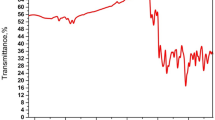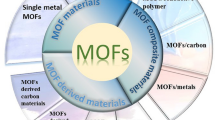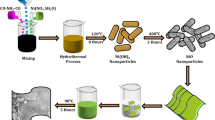Abstract
When the supercapacitor (SC) adopts electrolyte with solvent, the desolvation mechanism in the charging process is helpful for the electrode material to adsorb more electrolyte ions and improve the capacitance. However, the desolvation effect is temperature dependent, and it is difficult to achieve at low temperature. In this work, we find that the existence of a large number of submicropores (0.7–2 nm) in activated carbon greatly improves the SC performance at − 40 °C. The capacitance retention ratio can reach up to 90% compared with the value at 25 °C. We reveal both experimentally and theoretically a “gradual desolvation mechanism” from the thermal dynamic perspective. The solvent molecules energetically prefer to be removed from the solvated ion step by step in the submicropore. At the same time, we also found that the functionalized carbon nanosponge materials (FCNSs) with most of the submicro- and mesopore structure deliver a high specific capacitance of 131 F g−1, the capacitance retention ratio at − 40 °C can be about 100% at increased current densities of 1–10 A g−1. Moreover, the FCNSs also show excellent cycling performance at − 40 °C with no capacitance fading over 5000 cycles at 5 A g−1.

Graphical abstract





Similar content being viewed by others
References
Thomas CD, Cameron A, Green RE, Bakkenes M, Beaumont LJ, Collingham YC, Erasmus BF, De Siqueira MF, Grainger A, Hannah L (2004) Extinction risk from climate change. Nature 427(6970):145–148
Lawrence J, Ashley M, Hengst S, Luong-Van D, Storey J, Yang H, Zhou X, Zhu Z (2009) The PLATO dome a site-testing observatory: power generation and control systems. Rev Sci Instrum 80(6):064501
Matthews J, Smith A, Smith I (1979) A remote unmanned ELF/VLF goniometer receiver in Antarctica. Planet Space Sci 27(11):1391–1401
Cloyd JS A status of the United States Air Force’s more electric aircraft initiative. In: IECEC-97 Proceedings of the Thirty-Second Intersociety Energy Conversion Engineering Conference (Cat. No. 97CH6203), 1997. IEEE, pp 681–686
Sides CR, Martin CR (2005) Nanostructured electrodes and the low-temperature performance of Li-ion batteries. Adv Mater 17(1):125–128
Korenblit Y, Kajdos A, West WC, Smart MC, Brandon EJ, Kvit A, Jagiello J, Yushin G (2012) In situ studies of ion transport in microporous supercapacitor electrodes at ultralow temperatures. Adv Funct Mater 22(8):1655–1662
Xu J, Yuan N, Razal JM, Zheng Y, Zhou X, Ding J, Cho K, Ge S, Zhang R, Gogotsi Y, Baughman RH (2019) Temperature-independent capacitance of carbon-based supercapacitor from −100 to 60 °C. Energy Storage Mater 22:323–329. https://doi.org/10.1016/j.ensm.2019.02.016
Wang X, Xu J, Razal JM, Yuan N, Zhou X, Wang X, Ding J, Qin S, Ge S, Gogotsi Y (2019) Smoothly migration of ions in carbon electrodes with bimodal pores at ultralow temperature of-100° C. Journal of Materials Chemistry A
Kötz R, Hahn M, Gallay R (2006) Temperature behavior and impedance fundamentals of supercapacitors. J Power Sources 154(2):550–555
Xia X, Zhang Y, Chao D, Xiong Q, Fan Z, Tong X, Tu J, Zhang H, Fan HJ (2015) Tubular TiC fibre nanostructures as supercapacitor electrode materials with stable cycling life and wide-temperature performance. Energy Environ Sci 8(5):1559–1568
West WC, Smart MC, Brandon EJ, Whitcanack LD, Plett GA (2008) Double-layer capacitor electrolytes using 1,3-D ioxolane for low temperature operation. J Electrochem Soc 155(10):A716–A720
Miller JR, Simon P (2008) Electrochemical capacitors for energy management. Science 321(5889):651–652
Kotz R, Carlen M (2000) Principles and applications of electrochemical capacitors. Electrochim Acta 45(15):2483–2498
Miller JR, Burke AF (2008) Electrochemical capacitors: challenges and opportunities for real-world applications. Electrochem Soc Interface 17(1):53
Wang X, Zhou H, Sheridan E, Walmsley JC, Ren D, Chen D (2016) Geometrically confined favourable ion packing for high gravimetric capacitance in carbon–ionic liquid supercapacitors. Energy Environ Sci 9(1):232–239
Plichta EJ, Behl WK (2000) A low-temperature electrolyte for lithium and lithium-ion batteries. J Power Sources 88(2):192–196
Maricle D, Swarr T, Karavolis S (1992) Enhanced ceria—a low-temperature SOFC electrolyte. Solid State Ionics 52(1–3):173–182
Wang X, Li Y, Lou F, Buan MEM, Sheridan E, Chen D (2017) Enhancing capacitance of supercapacitor with both organic electrolyte and ionic liquid electrolyte on a biomass-derived carbon. RSC Adv 7(38):23859–23865
Ferrero G, Fuertes A, Sevilla M (2015) N-doped porous carbon capsules with tunable porosity for high-performance supercapacitors. J Mater Chem A 3(6):2914–2923
Wang X, Zhou H, Lou F, Li Y, Buan ME, Duan X, Walmsley JC, Sheridan E, Chen D (2016) Boosted supercapacitive energy with high rate capability of aCarbon framework with hierarchical pore structure in an ionic liquid. ChemSusChem 9(21):3093–3101
Zhou H, Liu C, Wu J-C, Liu M, Zhang D, Song H, Zhang X, Gao H, Yang J, Chen D (2019) Boosting the electrochemical performance through proton transfer for the Zn-ion hybrid supercapacitor with both ionic liquid and organic electrolytes. J Mater Chem A 7(16):9708–9715. https://doi.org/10.1039/C9TA01256G
Chmiola J, Largeot C, Taberna PL, Simon P, Gogotsi Y (2008) Desolvation of ions in subnanometer pores and its effect on capacitance and double-layer theory. Angew Chem Int Ed 47(18):3392–3395. https://doi.org/10.1002/anie.200704894
Prehal C, Koczwara C, Jäckel N, Schreiber A, Burian M, Amenitsch H, Hartmann MA, Presser V, Paris O (2017) Quantification of ion confinement and desolvation in nanoporous carbon supercapacitors with modelling and in situ X-ray scattering. Nat Energy 2(3):16215
Chmiola J, Yushin G, Gogotsi Y, Portet C, Simon P, Taberna P-L (2006) Anomalous increase in carbon capacitance at pore sizes less than 1 nanometer. Science 313(5794):1760–1763
Pean C, Daffos B, Rotenberg B, Levitz P, Haefele M, Taberna P-L, Simon P, Salanne M (2015) Confinement, desolvation, and electrosorption effects on the diffusion of ions in nanoporous carbon electrodes. J Am Chem Soc 137(39):12627–12632
Gao B, Zhou H, Yang J (2017) One-step preparation of nitrogen-doped graphene nanosheets for high-performance supercapacitors. Appl Surf Sci 409:350–357. https://doi.org/10.1016/j.apsusc.2017.03.015
Liu C, Wu J-C, Zhou H, Liu M, Zhang D, Li S, Gao H, Yang J (2019) Great enhancement of carbon energy storage through narrow pores and hydrogen-containing functional groups for aqueous Zn-ion hybrid Supercapacitor. Molecules 24(14):2589
Gao B, Zhou H, Yang J (2017) Hierarchically porous carbons derived from polyaniline by “nanotube seeding” for high-performance ionic liquid-based supercapacitors. J Mater Chem A 5(2):524–528. https://doi.org/10.1039/c6ta07927j
Zhou H, Liu M, Li Y, Liu C, Gao H, Cao Z, Zhang D, Jin X, Chen Q, Liu Y, Yang J (2018) Carbon nanosponge cathode materials and graphite-protected etched Al foil anode for dual-ion hybrid supercapacitor. J Electrochem Soc 165(13):A3100–A3107. https://doi.org/10.1149/2.0681813jes
Perdew JP, Ernzerhof M, Burke K (1996) Rationale for mixing exact exchange with density functional approximations. J Chem Phys 105(22):9982–9985. https://doi.org/10.1063/1.472933
Kresse G, Furthmüller J (1996) Efficient iterative schemes for ab initio total-energy calculations using a plane-wave basis set. Phys Rev B 54(16):11169–11186. https://doi.org/10.1103/PhysRevB.54.11169
Kresse G, Furthmüller J (1996) Efficiency of ab-initio total energy calculations for metals and semiconductors using a plane-wave basis set. Comput Mater Sci 6(1):15–50. https://doi.org/10.1016/0927-0256(96)00008-0
Islam N, Li S, Ren G, Zu Y, Warzywoda J, Wang S, Fan Z (2017) High-frequency electrochemical capacitors based on plasma pyrolyzed bacterial cellulose aerogel for current ripple filtering and pulse energy storage. Nano Energy 40:107–114. https://doi.org/10.1016/j.nanoen.2017.08.015
Funding
We acknowledge funding from National Natural Science Foundation of China (Grants 51702131, 51774151) and Natural Science Foundation of Jiangsu Provence, China (Grant SBK2017041705). The industrial activated carbon materials were supplied by Ningbo Mushan Advanced Material Co., Ltd. This work was also supported by Institute of Green Materials and Metallurgy (Grant 5501670001, 5501670002)
Author information
Authors and Affiliations
Contributions
Dr. Jianchun Wu and Chao Liu contributed equally to this work.
Corresponding authors
Additional information
Publisher’s note
Springer Nature remains neutral with regard to jurisdictional claims in published maps and institutional affiliations.
Electronic supplementary material
ESM 1
(DOC 2118 kb)
Rights and permissions
About this article
Cite this article
Wu, JC., Liu, C., Zhou, H. et al. Thermal dynamic study of the gradual desolvation in submicropores for carbon-based supercapacitor at low temperature. Ionics 26, 4695–4704 (2020). https://doi.org/10.1007/s11581-020-03575-9
Received:
Revised:
Accepted:
Published:
Issue Date:
DOI: https://doi.org/10.1007/s11581-020-03575-9




